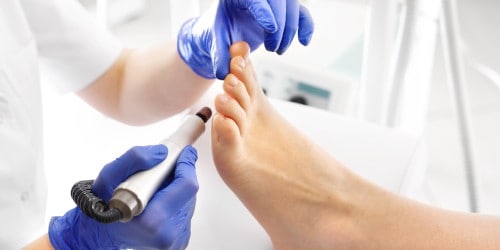- Home
- Foot & Ankle Conditions
- Toenails Conditions
- Ingrown Toenail
ingrown Toenail: causes, symptoms and treatment

What's an Ingrown Toenail?
An ingrown toenail (also called onychocryptosis) is a common foot problem that involves the nail curving down into the surrounding skin as it grows.
Once the edge of the nail breaks through the skin, it can produce inflammation and discomfort. Left untreated, an ingrown toenail may lead to infection, bone disorder, or a recurring problem.
- What are the common causes of an ingrown toenail?
- What are conservative treatment options for an ingrown toenail?
- What are ingrown toenail surgical treatment options?
- What is ingrown toenail surgery recovery like?
- The connection between ingrown toenails and paronychia
- University Foot and Ankle Institute, your best treatment choice for all toenail conditions
- Frequently Asked Questions about Ingrown Toenails and Toenail Removal
- How long does ingrown toenail surgery take?
- Is toenail removal generally covered by insurance?
- Can I wear shoes after ingrown toenail removal surgery?
-
Foot and Ankle Surgeon and Director of University Foot and Ankle Institute
Dr. Bob Baravaria DPM, FACFAS is a Board-Certified Podiatric Foot and Ankle Specialist. He is an assistant clinical professor at the UCLA School of Medicine and serves as Director of University Foot and Ankle Institute.
Dr. Baravarian has been involved in athletics his entire life and played competitive tennis in high school and college. He has an interest in sports medicine, arthritis therapy, and trauma/reconstructive surgery of the foot and ankle. He is also fluent in five languages (English, French, Spanish, Farsi, and Hebrew),
Learn More from our Ingrown Toenail Blog Articles
 Love this office-have to travel from Las Vegas, but so worth it-the gentle Dr Bob and his kind staff are the best!!Lori M.
Love this office-have to travel from Las Vegas, but so worth it-the gentle Dr Bob and his kind staff are the best!!Lori M. Overall, it was a great experience. I've been coming to Dr. Kellman for about a year and he and his staff are very helpful.Vanessa W.
Overall, it was a great experience. I've been coming to Dr. Kellman for about a year and he and his staff are very helpful.Vanessa W. ExcellentDebasish M.
ExcellentDebasish M. Everyone was friendly and professional.Victor L.
Everyone was friendly and professional.Victor L. So easy and smooth. Staff was friendly and helpful.Dr Briskin took terrific care of me and resolved my problem. Perfect experienceHank S.
So easy and smooth. Staff was friendly and helpful.Dr Briskin took terrific care of me and resolved my problem. Perfect experienceHank S. Very efficient and an excellent serviceHorwitz J.
Very efficient and an excellent serviceHorwitz J. Chaos in the office checkin. We weren’t forewarned about the iPad data collection. That made me late for a following appointmen...Carl C.
Chaos in the office checkin. We weren’t forewarned about the iPad data collection. That made me late for a following appointmen...Carl C. Dr Nalbandian is an exceptional doctor and person. The staff respectfully & compently delt with an issue I had regarding a prev...Karen M.
Dr Nalbandian is an exceptional doctor and person. The staff respectfully & compently delt with an issue I had regarding a prev...Karen M. I have severe Rheumatoid Arthritis and had severe pain on the inner part of my left ankle. Dr. Baravarian injected it and I wa...Maritza G.
I have severe Rheumatoid Arthritis and had severe pain on the inner part of my left ankle. Dr. Baravarian injected it and I wa...Maritza G. Visiting the office is a pleasurable occurance.Thomas J.
Visiting the office is a pleasurable occurance.Thomas J. Dr Kelman and his staff are always wonderfully caring and respectful to my father who has Alzheimer's dementia.Erland E.
Dr Kelman and his staff are always wonderfully caring and respectful to my father who has Alzheimer's dementia.Erland E. Thank you for being there for your patients.Dieter B.
Thank you for being there for your patients.Dieter B.




